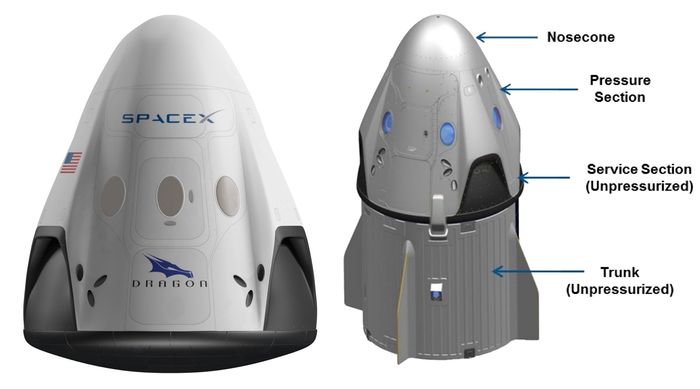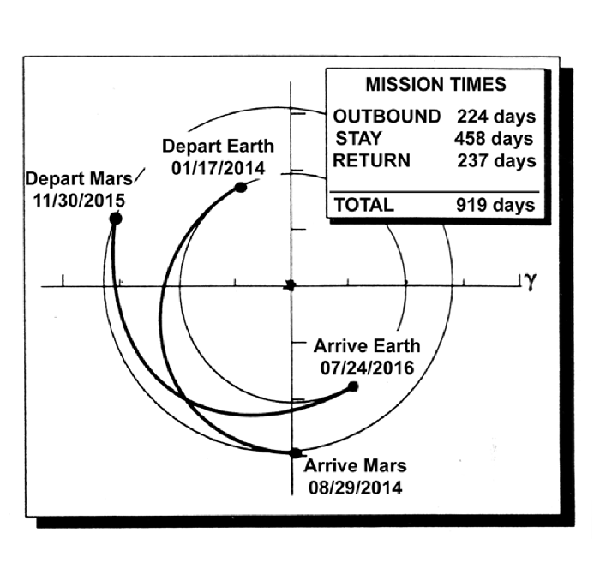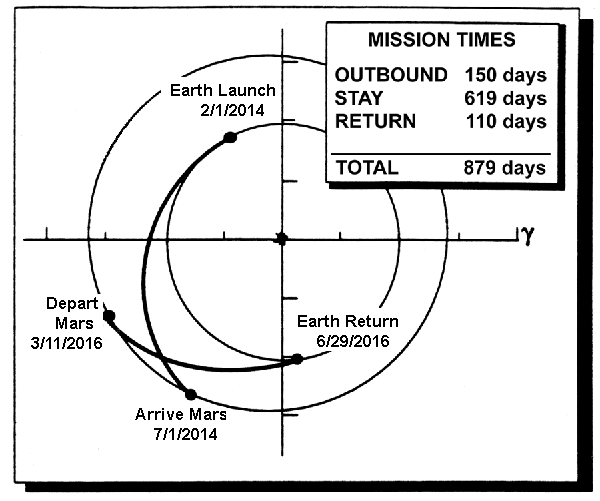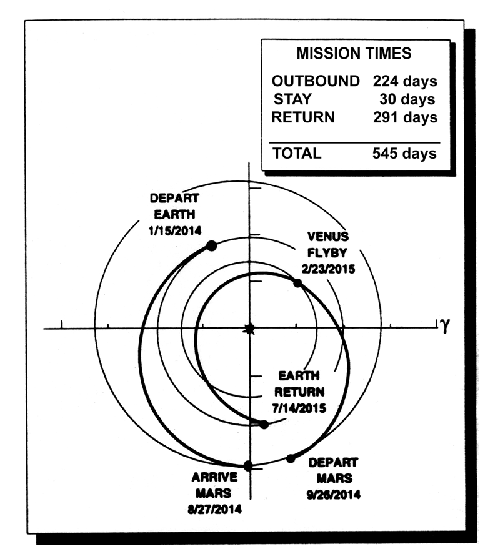New Mars Forums
You are not logged in.
- Topics: Active | Unanswered
Announcement
#26 2024-02-15 19:21:57
- SpaceNut
- Administrator
- From: New Hampshire
- Registered: 2004-07-22
- Posts: 28,939
Re: Forty 40 Ton Mars Delivery Mechanism
Cargo chucks are smaller than a Connex box and the delivery stage is greater than we might expect since we have reference numbers for 100 mT payload for a 100 mT of fuel in a dry ship of 120 mT that lands on mars.
Scaling back to the payload 40 mT means we need 40 mT of fuel or more with the ship structure taking 30 mT for the vehicle to deliver a Connex box of equipment.
Offline
#27 2024-02-16 17:34:23
- SpaceNut
- Administrator
- From: New Hampshire
- Registered: 2004-07-22
- Posts: 28,939
Re: Forty 40 Ton Mars Delivery Mechanism
I saw a blast from the past that have the legs more outward, but I think it still toppled on its last flight.
See Full Video at https://youtu.be/HMxcrTFO4Lc DC-X
Delta Clipper Experimental, was an uncrewed prototype of a reusable single-stage-to-orbit(SSTO) launch vehicle built by McDonnell Douglas in conjunction with the United States Department of Defense's Strategic Defense Initiative Organization (SDIO) from 1991 to 1993. Starting 1994 until 1995, testing continued through funding of the US civil space agency NASA. Built as a one-third-size scale prototype, the DC-X was never designed to achieve orbital altitudes or velocity, but instead to demonstrate the concept of vertical take off and landing.
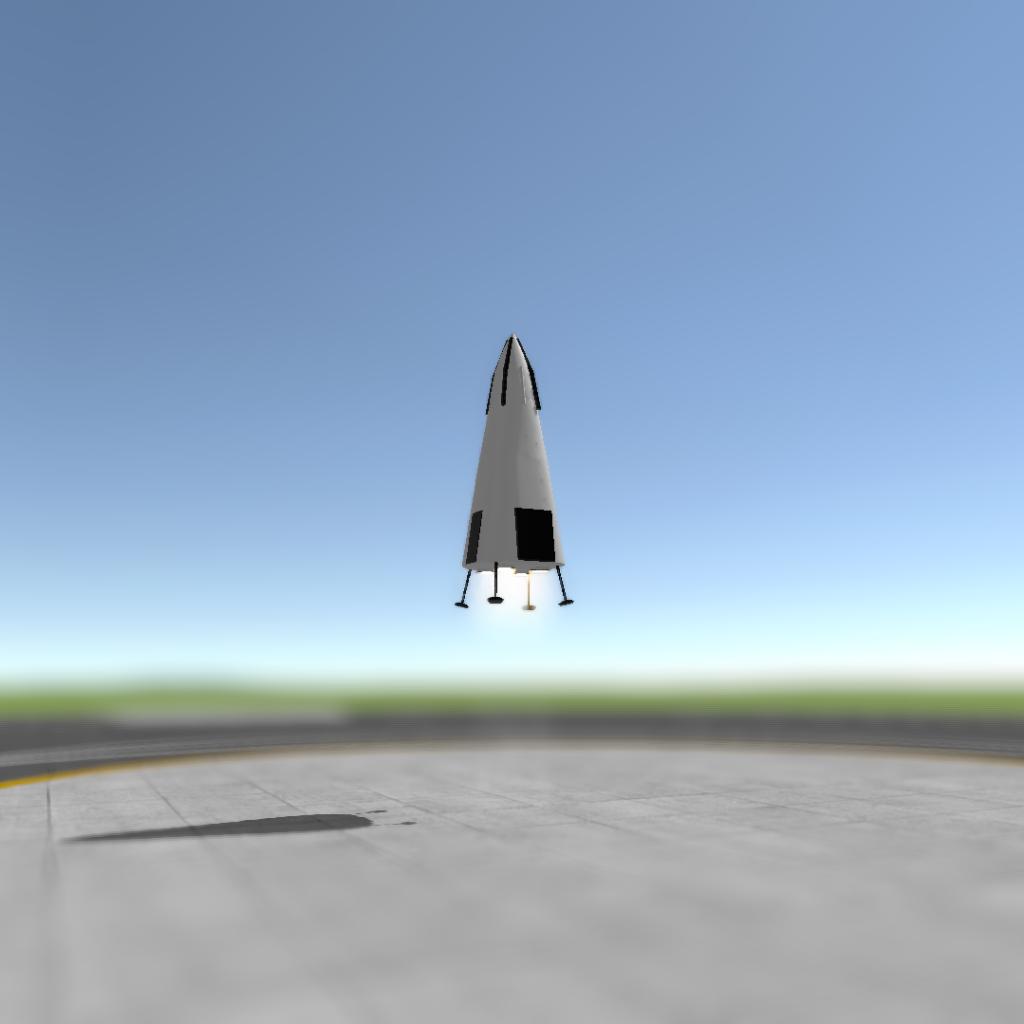

Offline
#28 2024-02-16 19:37:52
- SpaceNut
- Administrator
- From: New Hampshire
- Registered: 2004-07-22
- Posts: 28,939
Re: Forty 40 Ton Mars Delivery Mechanism
Of course, a scaled-up Dragon cargo might work but I sort of like the crewed dragon.

Similar is this art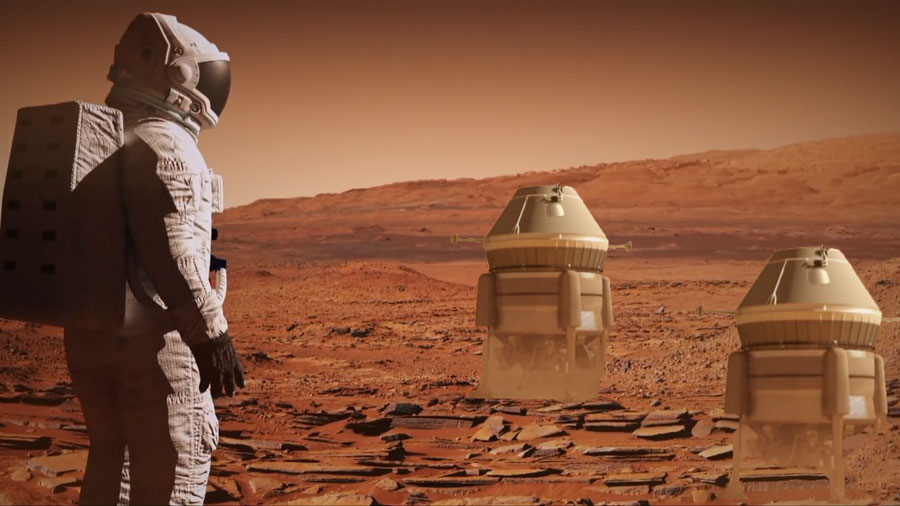
Nasa is looking for a future with inflatables in use a July 01, 1997 art.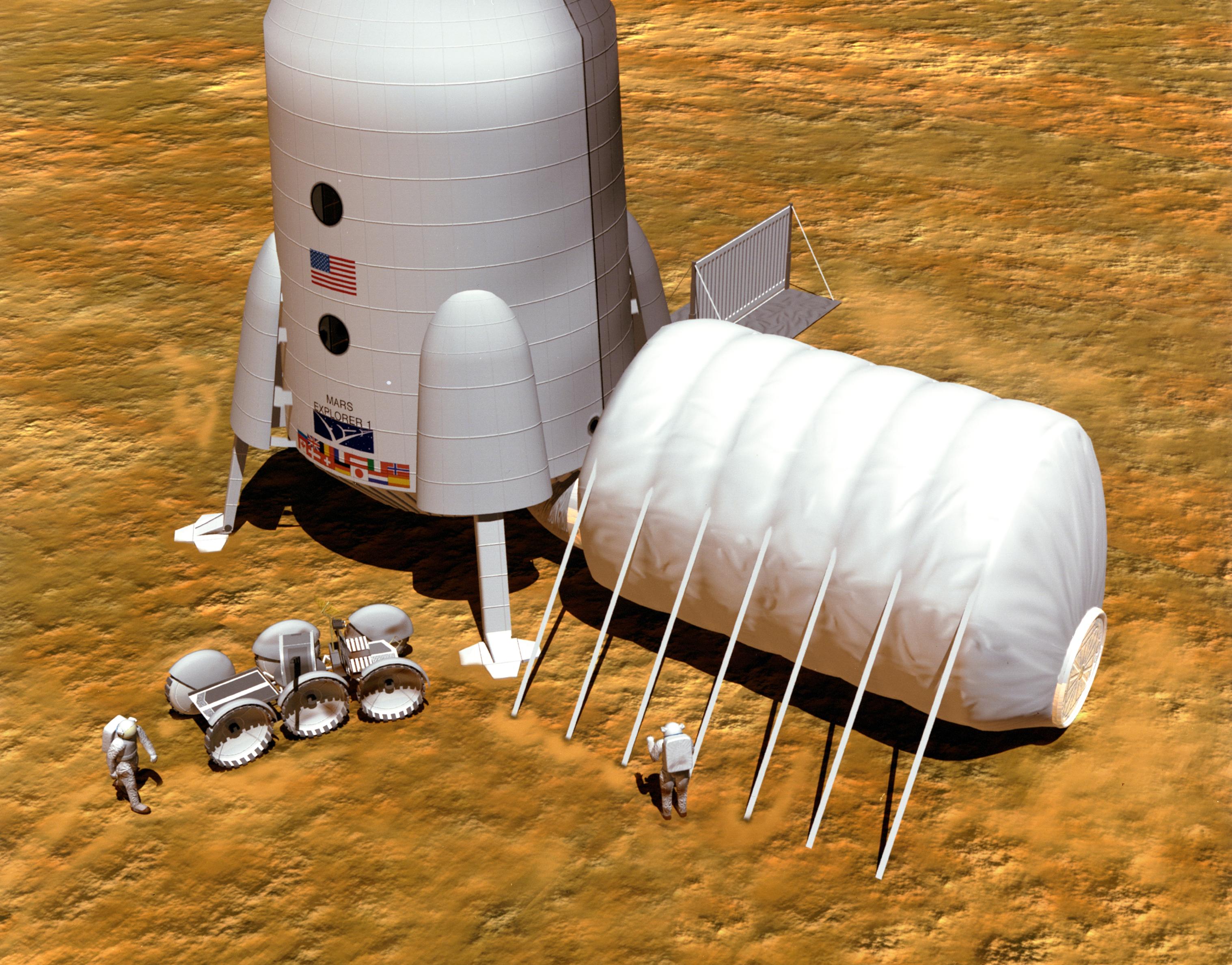
This is the knock off of the lunar, lander for 20 tons of cargo on the surface.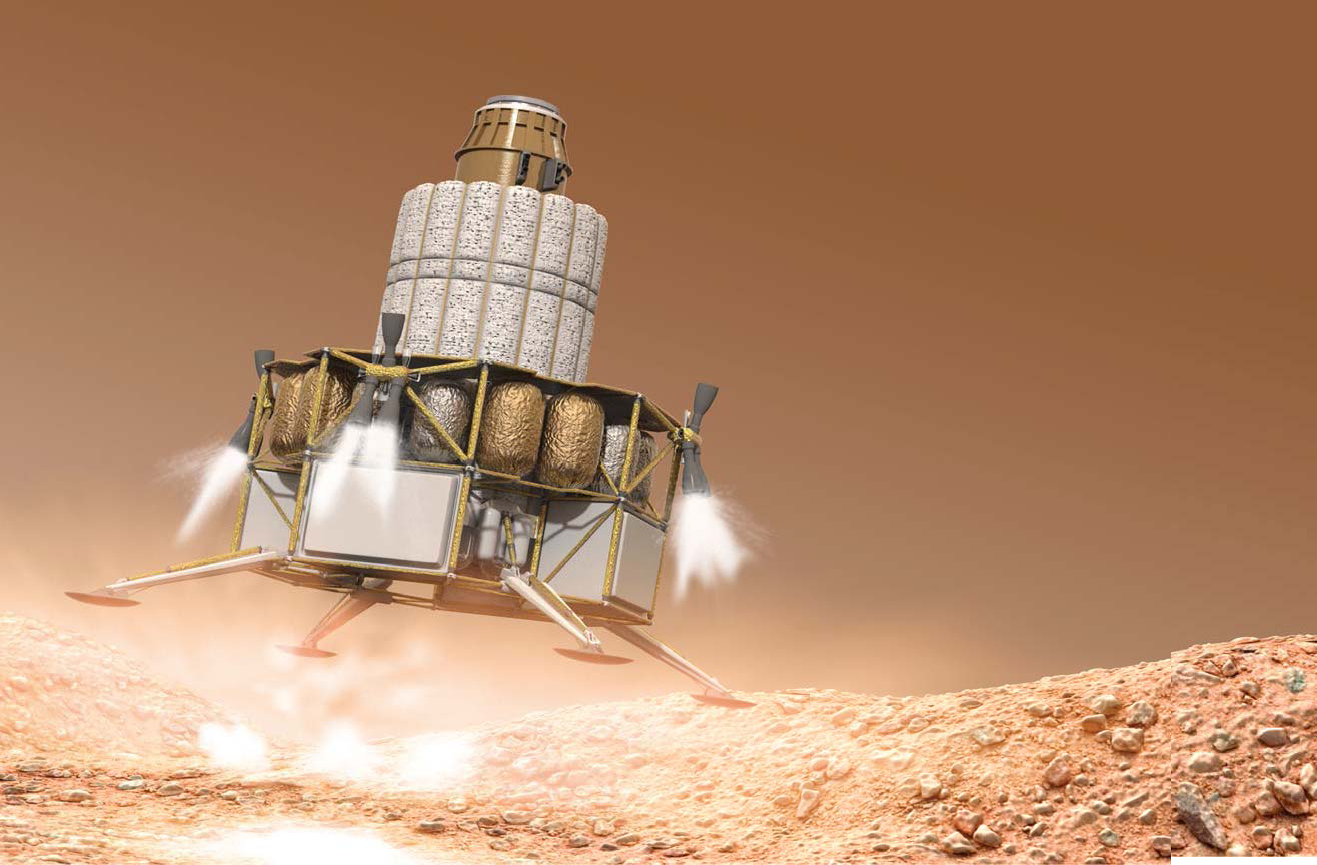
Landing humans on a minimal scale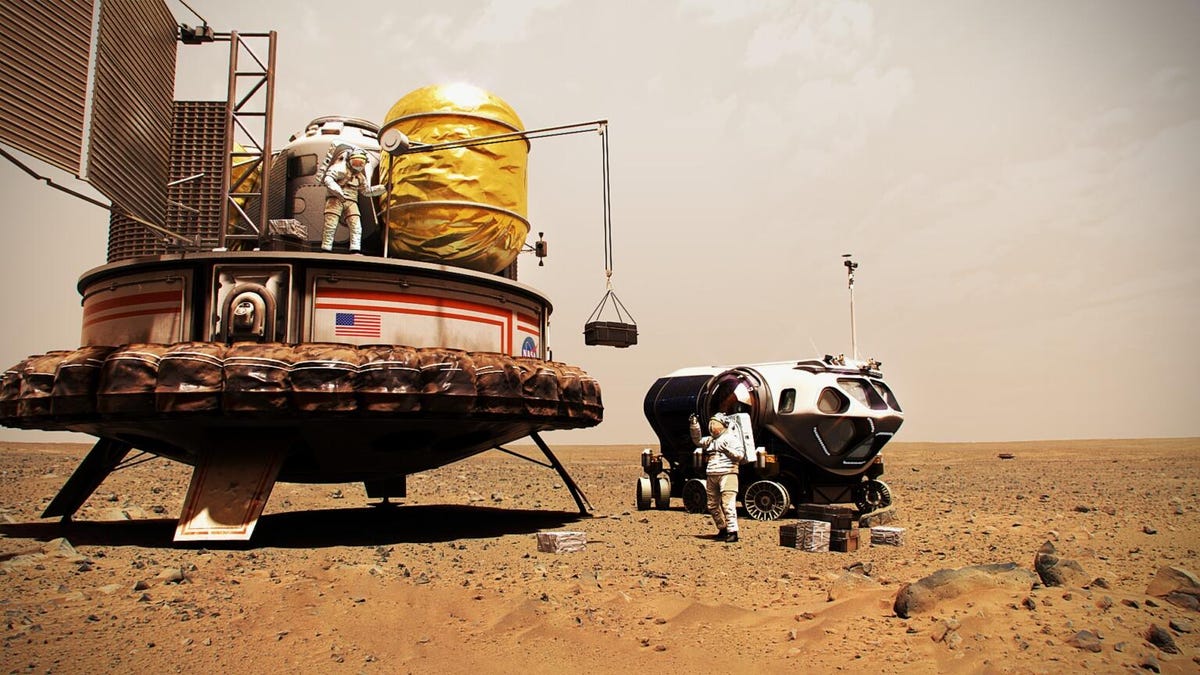
Mars Colonists Must 'Live Off the Land': https://ntrs.nasa.gov/api/citations/201 … 005963.pdf
Offline
#29 2024-02-18 18:32:19
- SpaceNut
- Administrator
- From: New Hampshire
- Registered: 2004-07-22
- Posts: 28,939
Re: Forty 40 Ton Mars Delivery Mechanism
Selecting a Trajectory for Human Missions to Mars
CONJUNCTION: LONG-STAY BENEFITS
» Shorter crew transit time between Earth and Mars: 160 – 180 days, same duration or shorter than typical International Space Station (ISS) crew rotation
» Over 500 days at Mars, allowing crews to conduct significant science and to thoroughly test equipment such as in-situ resource utilization (ISRU) that is required to sustain astronauts during future missions.
» Crew health can be maintained better on the surface of Mars than during long periods in deep space.
» More frequent launch windows: Approximately every 2 years
» Fewer technical challenges: Specifically, can be achieved with existing propulsion technology or with reasonable incremental developments.
» Long-stay missions will require less propellant mass for crew transport and will not require advanced propulsion or overcoming other major technical challenges that are necessary for short stay missions.CHALLENGES
» Longer total time away from Earth: Roughly 2.6 years.
» A longer mission requires more consumables and infrastructure mass. › More surface infrastructure, including power, environmental control and life support systems (ECLSS), and waste/trash management. Spare parts, and redundancy for critical systems and
supplies, will also be needed. The impact of carrying more mass for these items may be offset by the lower propulsive needs of this mission type.
» Additional crew members may be needed to maintain the site.
CONJUNCTION: FAST-TRANSIT LONG-STAY BENEFITS
» The transit times to and from Mars can be reduced by a month or more each way with less additional propellant mass than needed for Opposition-class missions.
» The trajectories never go inside the orbit of the Earth (i.e., 1 AU), reducing the thermal challenges, especially for cryogenic propellants, and reducing risk to the crew from solar radiation.
» The total time spent in microgravity and in deep-space radiation environments is lowest for this option.
» The surface times on Mars can be equivalent to the long-stay missions.CHALLENGES
» Total mission length could be roughly 2.4 years, depending on the propulsion system used and the budgeted propellant mass.
» Similar issues with surface infrastructure and redundancy as long-stay missions
» Scenarios have been developed that require additional propellent, in-space staging, a “lean” transfer facility, and higher velocity re-entry at the Earth to reduce significantly the time in free space.OPPOSITION: SHORT-STAY BENEFITS
» Shorter total time away from Earth: Roughly 1.8 years (Note: If the mission were to be conducted in 2033, a particularly favorable launch window, the time away from Earth would be 1.6 years)
» Requires significantly less precursor infrastructure preparation on the martian surface than is required for the long-stay mission (see long-stay requirements above)
» A short-duration mission could increase understanding of the requirements for long-stay missions before committing to a specific site.
» A 2021 NASA/Baylor College of Medicine technical memorandum estimated that a short-stay mission could result in decreased risk as compared to the standard mission (i.e., long-stay). Most of the risks cited in the study are associated with the likelihood of a medical emergency arising during the time span of the trip. The 420-day trip time used in the Baylor study for the short-stay mission, however, would be very difficult to achieve, even with advanced propulsion systems. A more realistic trip time would be 650 days, offsetting much of this benefit.CHALLENGES
» Less-frequent launch windows: as opposed to roughly every two years for the long-stay missions.
» Longer crew transit time: Total crew transit time would be approximately 650 days. In addition, their return trajectory would require the crew to travel much closer to the Sun, inside the orbit of Venus, increasing exposure to solar radiation and potentially solar storms (aka, coronal mass ejections).
» Larger propellant mass: required ΔV values average 3 times higher than long-stay.
» Probable need for advanced propulsion, such as nuclear thermal propulsion (NTP) or nuclear electric propulsion (NEP). These technologies are currently in the very early stages of research and development. Alternately, using conventional propulsion would require a substantially larger number of launches to position required fuel in space. The system complexity of advanced propulsion implementations may present development and mission reliability risks.
» Shorter surface time: 30 days, with only a small portion of this surface time dedicated to extra vehicular activities (EVAs).
» Far less productivity: It is unknown how long it will take for crews to adapt to the martian gravity after many months at zero g. Even in the best-case scenario, only limited amount of science, EVAs, and technology demonstrations will be conducted.
Offline
#30 2024-02-19 21:02:31
- SpaceNut
- Administrator
- From: New Hampshire
- Registered: 2004-07-22
- Posts: 28,939
Re: Forty 40 Ton Mars Delivery Mechanism

The mission plan has been for the Roughly 2.6 years CONJUNCTION: LONG-STAY Over 500 days at Mars with Shorter crew transit time between Earth and Mars: 160 – 180 days.
That means if the time of the window is 30 days on either end of the mission, we could conceivably get 60 additional days on mars for crew to be present requiring additional preplanned Martian cargo needs increase.
post table from Nasa Orion use
4 crew to make use of these consumed items before any recycling is done.
82 kg reference astronaut crew member means 1,394 kg for crew mass not even thinking about clothing.
Solar calculations for minimal capsule is 11 kw x 25 hrs is 275 kw an hour a day to support 4 people so for 17 we are needing 4.25 times as many to do the crew size that we are in need of.
Since we know that we need 3 parts to the journey the solar arrays must be able to be repacked back into the ships system when landing and be redeploy able once on the surface. The solar needs to be expandable once on the surface which means extra unused batteries are required.
Based on a crew of 4 the need is 11 kw continuous which means a need of 5 kilo watt reactors or more to power a mars surface for a for each part of the journey with solar providing what Nasa did neglect with a capsule.
need to calculate from start of each part of the journey.
Nasa has pegged power at 11 kw continuous per 4 men on a closed tent camping mode that does not count for energy needed to do recycling of human waste streams and for processing new assets to restock these consumed items.
It does not even look at food as we know we will need to do with gardens. Nasa on its use of Orion for mars has neglected to include other requirements for oxygen and water such as module leakage, science experiments, and extravehicular activity (EVA).
EVA can be a source of consumables loss in several ways, such as the airlock, cooling systems that vent water, and non-regenerative CO2 removal systems in the space suit.
240 kg of water in four tanks (960 kg) is used for a crew of 4 for 21 days. So, for the mission stay we need 537.6 mT to start if no recycling is done.
The kbd512 recommended ISS recycling is 2 racks and such has a mass that would come out of the payload. budget and would be only active once on the mars surface with nuclear power and a crew to install for use. In addition to the one onboard the crewed ship.
It recovers water and we must have an oxygen generator similar to the Russian ISS unt to make use of the recycled with co 2 to get more water for use.
Other things to think of is the amount of clothing and will we wash them.
Clothes Cleaning Research for Space Exploration
A Trip to Mars Wish List for Apparel and Habitat
Will Astronauts Wash Clothes on the Way to Mars?
Launcher size optimization for a crewed Mars mission
Design reference missions.
https://en.wikipedia.org/wiki/Mars_Desi … ce_Mission
we have the drm-5 topic in human as well.
What is the error on oxygen?
Orion has for a crew of 4 they need for 21 days just 90 kg of oxygen in three tanks (= 270kg), 30 kg of nitrogen for near normal air
With space suits give another 144 hours. The amount of Oxygen is 151.2 mT to preplan to the surface.
Nuclear power required to use equipment to produce rather than suppling. At 300 watts to get about 6 g to 12 g which a far cry for an hour runtime when we need roughly 600 g for a days' worth of breathing per crewman. 600g x 4 x 560 = 1,344 mT so something is off with the baseline oxygen numbers from Orion.
Last edited by SpaceNut (2024-02-22 18:44:39)
Offline
#31 2024-02-20 06:34:11
- kbd512
- Administrator
- Registered: 2015-01-02
- Posts: 7,438
Re: Forty 40 Ton Mars Delivery Mechanism
SpaceNut,
They're going to need to land at least 4 of these 40 ton payloads to maintain margins required for crew survival. A lot of the delivered tonnage will consist of food, water, and atmosphere.
If you start off with 200 gallons of potable water per person, use 28 gallons per person per week, achieve 98% water recovery efficiency from the weekly batch processing of the brine you recycle through the water processor (achieved aboard ISS, so obviously doable), and you need to survive for 4 years using only the water you have onboard, then you end up with 83 gallons at the end of 208 weeks of total mission duration. 800 gallons weighs about 3t. I wouldn't take any less than that for a crew of 4, and I would allocate that much water amongst all 4 landers, to ensure that the crew has a water source for survival. The crew also needs 7,305kg of food over 4 years as well (1.25kg per person * 4 crew * 365.25 days per year * 4years). Again, that tonnage must be allocated to each lander. There's probably another 200kg of sanitary and medical supplies to allocate to each lander. Whatever tonnage is left can be allocated to equipment, scientific experiments, vehicles, batteries, electronics, etc. Extra water will be required to create Oxygen and replenish losses from EVAs. Nitrogen can be stored in the form of Ammonia, with the Hydrogen turned into fuel for PEM fuel cells that produce water as a byproduct. A power source is also required, preferably nuclear so that it doesn't require any fuel or ambient energy to operate.
Between all that stuff, you should have what you need to survive on the surface for at least 2 years, or 4 years if there's a problem getting back off the surface, which would imply the next missions are cargo resupply in addition to another Mars Ascent Vehicle (MAV), hopefully one that works the second time around.
The MAV needs to be NTO/MMH powered so that it doesn't require ISRU. We'll have to figure out how to do ISRU after we get there, and doing that requires a lot of continuous electrical power.
I would land 40 tons of water tank, about 7,900 gallons of water assuming the stainless steel tank structure is 10% of the delivered payload mass, as the first payload, just to be sure the landers work. So long as the second lander can land nearby to demonstrate precision landing, along with the 3rd and 4th lander, then we don't need to include more water in the subsequent landers.
Offline
#32 2024-02-20 11:57:25
- kbd512
- Administrator
- Registered: 2015-01-02
- Posts: 7,438
Re: Forty 40 Ton Mars Delivery Mechanism
1. SuperDraco thrusters provide 7.26 metric tons-force each, 235s Isp using their tiny non-vacuum-optimized nozzle design (possibly 270s with much larger vacuum-optimized nozzles), and they burn NTO/MMH, which is our current storable bi-propellant combo of choice.
2. Let's say we have 8 of these thrusters per lander, mounted up top in the lander similar to the Sky Crane configuration to minimize potential payload damage and allow for engine gimbal to some degree, the lander has a 50t wet mass, and on Mars that translates to 19t.
3. The reentry heat shield should weigh 2t at most, which we "drop" and then proceed to a pure propulsive landing without parachutes, which are impractical at this size.
4. Our engines can apply a maximum of 58t of braking force, which means we have 3X more thrust than is required to "hover", not that we're going to do anything but plant our lander.
5. We use Falcon booster Aluminum "crush tube" landing legs, which are flight-proven single-use impact absorbing wide-track (for this size payload) landing gear.
We don't need to reinvent the wheel here, because we won't be using a lot of these. They need to be cheap, disposable landers cobbled together from all our existing engine, landing gear, PICA heat shield, and NASA-tested / approved cargo stowage technology. Crew-Transfer Bags for food / meds / supplies / science instruments, Orbital ATK Cygnus cargo capsule as a water or Ammonia tank, etc. Spend intellectual and monetary capital elsewhere. Make the landers as simple and robust as we reasonably can.
We can partially test this on the moon using extra steel to simulate the weight of the lander on Mars, primarily by using a thicker steel water tank as a solar storm shelter for the astronauts returning to the moon. We have to deal with atmospherics on Mars, but that's the only part we can't test on the moon simply by making the landed payload 21% heavier than it needs to be for Mars. The lander can be assembled on-orbit, if need be.
Starship could take the lander simulator up, then perform a second mission to attach a solid or NTO/MMH powered upper stage to perform TLI. There's no LOI burn since we're doing direct EDL to the surface of the moon, sort of like the proposed Nova-based direct-ascent lunar missions that were not selected over Saturn V / Apollo / LOR for various reasons. For 200t IMLEO and 270s Isp, you get 3.28km/s delta-V, which means 2 Starship missions to TLI a 58t payload, so first mission launches the payload, second mission launches the booster, both mission well within Starship's reusable lift capability. With LOX / LCH4 and 380s Isp, given 150t IMLEO, you can TLI a 58t lander in one launch.
Offline
#33 2024-02-20 12:12:03
- kbd512
- Administrator
- Registered: 2015-01-02
- Posts: 7,438
Re: Forty 40 Ton Mars Delivery Mechanism
GW,
If the large ship was assembled and boarded in high lunar orbit or halo orbit, is there a way to use electric propulsion for the large ship and the Earth itself as a "slingshot" to send it to Mars?
Alternatively, what about using GEO orbit from Earth for the large ships?
That avoids the radiation problem and a lengthy spiral out from Earth using electric propulsion. You need 2 Starships to do it, but Starship never has to leave Earth for any significant period of time, so the large ship can be optimized for artificial gravity, crew protection, and crew provisions mass vs propulsion system mass. It adds some complexity, but spiraling out from LEO is a lot more time and requires very heavy radiation shielding for the crew. The all-in-one solution of Starship means it can't be optimized for any part of the mission, and remains beholden to reentry and upper stage heat protection and propulsion requirements.
Offline
#34 2024-02-20 14:03:52
- Calliban
- Member
- From: Northern England, UK
- Registered: 2019-08-18
- Posts: 3,446
Re: Forty 40 Ton Mars Delivery Mechanism
In a previous post, which I have unfortunately lost track of, you described the use of satellites that would generate plasma beams capable of enacting impulse on craft equipped with magnetic field generators. Perhaps a system like this could be used to propel supplies from LEO to HEO? The good thing is that inert supplies could take months to reach HEO without any problems. Sensitive electrical equipment and live animals should not be shipped this way because of the accumulated dose from the Van Allen belts. But for food, water and propellant, long journey times may not be problematic.
People could be shipped quite comfortably from LEO to HEO using a cycler on a highly elliptical orbit. A very lightweight taxi vehicle would accelerate the passengers to rendezvous with the cycler as it passes through LEO space. If the taxi only need carry the passengers for a few hours, then cramped conditions can be tolerated. The cycler would protect passengers from cosmic radiation and Van Allen belt radiation for most of the trip. The taxi would then ferry passengers from the cycler apogee in HEO to the large ship.
Last edited by Calliban (2024-02-20 14:06:09)
"Plan and prepare for every possibility, and you will never act. It is nobler to have courage as we stumble into half the things we fear than to analyse every possible obstacle and begin nothing. Great things are achieved by embracing great dangers."
Offline
#35 2024-02-20 17:45:15
- kbd512
- Administrator
- Registered: 2015-01-02
- Posts: 7,438
Re: Forty 40 Ton Mars Delivery Mechanism
Calliban,
Those would likely be seen as and used as directed energy weapons at some point, because they're dual-use technology. I gave up on that idea and reconsidered fully tested or highly developed propulsion systems. We have chemical, multi-hundred kilowatt solar electric propulsion, and small nuclear reactors or RTGs for long duration electric power. If the uncrewed transfer vehicle in question can spend months spiraling to GEO, then onboard power for electric propulsion is not terribly problematic. Such vehicles can be serviced or have their propellant replenished in LEO by Starships.
I go back-and-forth on these advanced propulsion concepts. They hold great promise, but they're very expensive and time consuming to develop. Apart from 10+ years into the future, I don't know if the juice is worth the squeeze. It would be great to get on with the process of testing the hardware for the first Mars exploration missions and reprise of the Apollo program. I really liked the directed energy idea because it could clean up space debris as well, which is increasingly hazardous. The ability to intercept ICBMs or nudge asteroids from Earth's orbital path was an unintended bonus.
If the point isn't clear, I view this topic as getting on with the process of developing hardware for the exploration missions, which must precede any colonization attempts.
Offline
#36 2024-02-20 18:56:00
- GW Johnson
- Member
- From: McGregor, Texas USA
- Registered: 2011-12-04
- Posts: 5,463
- Website
Re: Forty 40 Ton Mars Delivery Mechanism
The base of the Van Allen belts is a fuzzy thing, but is considered to start at an altitude above the surface of 900 miles = 1600 km. GEO is definitely in the Van Allen belts.
There is no reason that electric propulsion cannot be used from LEO or GEO. It just takes a long time to spiral out, more for LEO than GEO. If you do that with people or sensitive cargo aboard, you will have to supply radiation shielding of some kind, and nothing trivial.
There is a well known exception to the 1600 km rule-of-thumb for getting exposed to potentially-lethal Van Allen belt radiation. It is the South Atlantic Anomaly, where the belt seems to extend down below the altitude of the ISS. It takes several minutes an orbit to transit this, which is where the majority of radiation exposures on the ISS really come from.
You do not transit the South Atlantic anomaly if your orbital inclination is low, essentially near due eastward. The more inclined it is, the longer your exposure in that anomaly, each time you transit. You don't hit it every orbit, but when you do hit it, you get a dose.
GW
GW Johnson
McGregor, Texas
"There is nothing as expensive as a dead crew, especially one dead from a bad management decision"
Offline
#37 2024-02-20 19:00:38
- SpaceNut
- Administrator
- From: New Hampshire
- Registered: 2004-07-22
- Posts: 28,939
Re: Forty 40 Ton Mars Delivery Mechanism
The moment we go to needing more than 1 ship to achieve this small quantity of crew we are not going as we cannot even get off from Mars surface. Starship is just that problem only larger.
Let's focus on crew, food water and air to bound the first landings and then see what we can achieve as when we do duplicate spread out, we do not do any better.
Iss unit is closer to 90 and when it fails its down for long periods of time that crew cannot go without water.
Food is not going to be all that fresh after the outbound start.
We cannot get restocked as the returning crew has left just prior to the incoming launch so as to time it correctly.
Offline
#38 2024-02-20 20:38:06
- kbd512
- Administrator
- Registered: 2015-01-02
- Posts: 7,438
Re: Forty 40 Ton Mars Delivery Mechanism
SpaceNut,
Salt lasts forever. Honey can last for a thousand years or so. Canned beans, 30 years. White rice, 25 years. Anything made with flour should last 8 years, meaning pasta and hard tack. Pemmican lasts for 10 to 20 years. Even Pemmican with dried fruits and nuts should last for at least 5 years. USDA says frozen foods are safe indefinitely, but may not taste great after a year or so. Mars and deep space are cryogenically cold. I don't see an advance mission to drop food and water on the LZ being that big of a deal. Even MREs which have not been stored properly will last for many years. They won't taste very good, but nobody died from eating them. The food will be fine. Our food tech has that problem sewn up tighter than a drum.
Some meds and medical supplies will need to be taken along with the crew, or possibly made from scratch with appropriate QC, such as insulin. Restocking won't be a problem because we'll bring more than we think we'll need, and also keep food supplies separated in case something happens to a particular lander or vehicle. Dying of starvation or thirst on another planet is dumb, so we make sure that doesn't happen using backups. We'll do the same thing with medical supplies, life support equipment, and power supplies.
We know all of our basic life sustaining tech is good enough to survive in a very harsh orbital environment for 20+ years, so 2 years on the surface of Mars should be a cake walk. We're going to use the lunar surface as an acid test to ensure that abrasive volcanic dust doesn't mess up the life support equipment.
Offline
#39 2024-02-21 07:43:18
- tahanson43206
- Moderator
- Registered: 2018-04-27
- Posts: 17,280
Re: Forty 40 Ton Mars Delivery Mechanism
This topic is about the technology needed to deliver 40 tons to Mars.
This topic is NOT about the materials to be delivered.
We have many other topics for discussion of payloads to be delivered.
SpaceNut, since you are Senior Administrator, if is part of your responsibility to set a good example for your Junior Administrator.
I can work with members who drift off topic. I can't do much when the Senior Administrator and the Junior Administrator BOTH take the topic off and away from it's focus.
(th)
Offline
#40 2024-02-21 09:52:07
- kbd512
- Administrator
- Registered: 2015-01-02
- Posts: 7,438
Re: Forty 40 Ton Mars Delivery Mechanism
tahanson43206,
Apologies. I didn't intend to diverge away from the core topic, only to suggest that nominal cost payloads, which would be required to sustain human life after they land on Mars, are also good payloads for testing purposes. If the landing test succeeds, then you have supplies already landed that people will need to live on Mars. If not, then it's not as bad as loosing a multi-billion dollar rover laden with hand-crafted scientific instruments, assuming the goal is to spend money to do great things.
Cygnus, for example, has internal volume sufficient to carry at least 27 cubic meters of water. The PCM weighs 1,800kg. That's a 28.8t test payload. For purposes of testing, water is relatively easy to ship and control. This is relevant because not every flight during the test program is guaranteed to succeed.
I intended to suggest that the wheel doesn't need to be reinvented for NASA's 40t Mars cargo lander. Cygnus is a readily available and fully developed cargo shipping container that the tax payers have already paid for the development of. It doesn't need to be reinvented, so other problems can be solved using the available time and money, such as building a viable Mars cargo lander. If you don't waste time / money / brain power reinventing the shipping container, engines, heat shield, or landing gear, then you get to focus all your money and effort on the practical engineering aspects of designing a reliable nominal cost cargo lander suitable for supporting crewed Mars exploration missions. That is what you do when you're more interested in the actual exploration of space than the idea of it.
Cygnus - reliable human-rated cargo container, about 3X more volume than a Dragon capsule
SuperDraco - reliable human-rated space capsule engine with sufficient thrust to successfully land
PICA - reliable / lightweight / low cost heat shield material for disposable heat shields used by Dragon capsules
Falcon Landing Gear - reliable / lightweight / low cost landing gear to land the booster stage of a human-rated rocket
Everything on that list is TRL9, because the engineering task is landing 40t on Mars. This is what I would do as the program manager at NASA, because I'm only interested in achieving the result in an expeditious and cost-effective manner. I couldn't care less if it's 2.31% less efficient than it ever possibly could be. After we successfully achieve the desired result, then I will tell my engineering team they are free to optimize the design.
Offline
#41 2024-02-21 10:32:26
- GW Johnson
- Member
- From: McGregor, Texas USA
- Registered: 2011-12-04
- Posts: 5,463
- Website
Re: Forty 40 Ton Mars Delivery Mechanism
The Falcon landing gear works on hard concrete pads and steel ship decks. It won't work in dirt, because it has a small actual bearing surface area that will stab deeply in. This will inherently happen asymmetrically (because of Murphy's Law if for no other reason), leading to topple-overs of taller vehicles.
What you want at the tip of your landing leg is a flat pad sized for safe bearing pressures upon loose dry fine sand, and dynamically, NOT just statically! That's what was on the Apollo LM. That's what was on Surveyor. That's what was on Viking. Shall I go on?
GW
GW Johnson
McGregor, Texas
"There is nothing as expensive as a dead crew, especially one dead from a bad management decision"
Offline
#42 2024-02-21 10:45:31
- tahanson43206
- Moderator
- Registered: 2018-04-27
- Posts: 17,280
Re: Forty 40 Ton Mars Delivery Mechanism
For all contributing to this topic .... thanks to everyone helping to build up this topic! I am hoping this will become a reference for folks who are seriously thinking about this problem. A small digression to consider possible payloads is part of the mix. I am glad to see us returning to a sharp focus.
I don't know the answer to this, but would like to toss out the question... Why not just land on the heat shield?
Ports for engines can be uncovered after the heat shield has done it's job, and just slid back from the rim.
A landing system designed with that feature would have the payload mass at the center and low in the heat shield, and all the rocket paraphernalia would be above the payload.
This would be a non-reusable lander, but ** all ** the rocket components could be unbolted and reassembled into something like one of GW's Hoppers.
(th)
Offline
#43 2024-02-21 12:52:09
- kbd512
- Administrator
- Registered: 2015-01-02
- Posts: 7,438
Re: Forty 40 Ton Mars Delivery Mechanism
GW,
This is a one-way cargo mission. It's not a science mission with a bunch of delicate scientific instruments. Whether the cargo can is 1m or 3m above the surface is irrelevant. If it's tilted one way or the other a few inches, it doesn't matter. We don't want the lander going anywhere at all after it lands, meaning no bouncing or hopping. If the landing gear immediately sinks into the regolith upon landing, then that is a good thing, because it reduces the height of the payload over the ground and anchors it to the ground. If the landing pad is a real problem, a slightly modified landing pad also strikes me as something which should be relatively simple to re-engineer. Going to a clean sheet with new engines, new heat shields, new cargo storage, etc, is something that will both take a long time, likely longer than necessary, and cost a lot of money that could be devoted to other development programs, such as life support or endurance testing, etc.
Offline
#44 2024-02-21 13:55:10
- GW Johnson
- Member
- From: McGregor, Texas USA
- Registered: 2011-12-04
- Posts: 5,463
- Website
Re: Forty 40 Ton Mars Delivery Mechanism
There's no need for a "clean sheet" design. But there is a need to modify the Falcon-type landing legs for use in soft dirt. The tip of it needs to hinge to rest flat on the soft surface. Depending on where you put the hinge line, you can get a lot of pad area with just the last foot or so of leg length hinged and sprung to lie flat.
If you do it as hinged and sprung, so that it only flattens out as weight is applied, it will also scoop up a load of regolith atop the flat-lying pad. That's ballast against any sort of hopping or bouncing.
What ever mass this thing has at touchdown, that has a Mars weight. That's the static force. The problem is there's dynamic amplification effects, because the velocity is not zero, just some small value, upon striking the surface. The usual engineering practice for this kind of low-speed strike is to factor up the static weight by 2 and use that as the dynamic force estimate. This has a very long history of being adequate in civil engineering designs.
There is also a transient geometry effect. Statically, the load on each leg is the Mars weight divided by the number of legs. But dynamically at touchdown, one leg invariably hits first, with other legs following shortly after, one-by-one. There is an inherent and inevitable crookedness to the vehicle attitude as it lands, plus the inherent crookedness of the shape of the surface. Worst case for 1 leg hitting first out of four legs would be to factor up the static Mars weight by 4 for this effect, but you don't need that much overkill. A factor of 2 is likely good enough, just because the time to fail or time to dig into the surface is finite, not zero.
So, my recommendation is to work in Mars weight and the sum of all the landing pad areas, since you do not know which leg hits first, and you may not yet know the total number of legs (3?, 4?, 6?, etc.). Take the static Mars weight and factor it up by 4 (that's 2 for dynamic impact, and another 2 for hitting crooked on 1 leg first). That's your "dynamic force" for pad design not to sink in on the transient. Divide that by the allowable bearing pressure for the soil, and that's your total pad area for all the legs combined. Only one leg will come anywhere near to mashing that hard on the ground, and then only for a split second. But that kind of design worked fine for the landers I mentioned above.
Bear in mind that ~98% of Mars is little different from dry, fine, loose sand here on Earth. So also was the moon. The presence of loose rocks in that sand does not make it any stronger, not until there are so many loose rocks that the vast majority are in physical contact, with sand only filling the interstices. The allowable bearing pressure for such is 0.1 MPa ~ 1 US ton/sq.ft. The actual failure pressure is about twice that.
For a 1-shot cargo delivery in a tough container, you could probably get away designing to the failure bearing pressure, instead of the allowable. But for a manned craft, use the allowable. You don't want a load of regolith on your pads overloading the mass to lift off again.
Not only did I design flight stuff, I did some foundations, too. And some thrust blocks and dead-man weights for underground water mains. I know how dirt works under applied forces. And it's not as strong as most folks think.
GW
Last edited by GW Johnson (2024-02-21 13:57:18)
GW Johnson
McGregor, Texas
"There is nothing as expensive as a dead crew, especially one dead from a bad management decision"
Offline
#45 2024-02-21 14:40:03
- kbd512
- Administrator
- Registered: 2015-01-02
- Posts: 7,438
Re: Forty 40 Ton Mars Delivery Mechanism
GW,
I'm not talking about taking Falcon 9's exact landing legs, as-built, and making zero mods to account for anything. I'm talking about using a basic design repeatedly proven to work. If Boeing or Lockheed have something better available, then we use that. This is not a crewed lander, and it's never going anywhere after it lands. This is a minimum cost single-use / one-way cargo lander. It's only reason to exist is to pre-stage supplies for humans to use.
Offline
#46 2024-02-21 15:35:31
- tahanson43206
- Moderator
- Registered: 2018-04-27
- Posts: 17,280
Re: Forty 40 Ton Mars Delivery Mechanism
For all participating in the topic ... I went back and looked, and the opening post does not specify the nature of the 40 tons. Neither does it specify if the landing vessel is to be reusable or a one-time system.
I see no good reason for a difference of opinion caused by uncertainty about the mission of this topic.
I have the ability to change both the title and the text of the mission statement for this topic. I am open to guidance on how to proceed. I ** do ** want this topic to be worth someone's time. Differences of opinion caused by failure to define the mission for the topic is something I can fix. I like the idea of ** BOTH ** options, but clearly they cannot exist comfortably in the same topic.
I'd appreciate some guidance here.
(th)
Offline
#47 2024-02-21 18:01:41
- SpaceNut
- Administrator
- From: New Hampshire
- Registered: 2004-07-22
- Posts: 28,939
Re: Forty 40 Ton Mars Delivery Mechanism
This topic is about the technology needed to deliver 40 tons to Mars.
This topic is NOT about the materials to be delivered.
We have many other topics for discussion of payloads to be delivered.
SpaceNut, since you are Senior Administrator, if is part of your responsibility to set a good example for your Junior Administrator.
I can work with members who drift off topic. I can't do much when the Senior Administrator and the Junior Administrator BOTH take the topic off and away from it's focus.
(th)
My post 29/30 are incomplete to answer straight quantities or mass tolerance cause by time shifts.
The mission plan has been for the Roughly 2.6 years CONJUNCTION: LONG-STAY Over 500 days at Mars with Shorter crew transit time between Earth and Mars: 160 – 180 days.
The issue is only partly a mass to move equation but a volume as well as what is on the ship as well as when.
Engines, fuel & tanks, and structural shell plus legs are just one side of it as mission tolerance effect even this stuff not just the ship going to mars.
The creep of design happens when someone strays, when options like recycling are added without knowledge of system maintenance issues. As the extra mass must come from a known mass add volume change as well as power change from adding more powered items on wattage limited supply.
Just the design change on any of the times changes each value in the manifest of what is on the ship and number of crew it can supply even under a or any or all failure modes that can happen for unplanned material supply needs.
So, what happens when the co scrubber fails, or the waste recovery fails to recover the water content.
GW, can answer the engineering question on time caused changes to fuel plus engines and structural mass shifts from volume caused changes and any other power we have others which can find what needs to happen from base line established by solar / nuclear requirements.
Thanks to Void we have another to make use of in "Mars Direct 3 is a Mars mission architecture developed by Miguel Gurrea" topic.
https://www.marspapers.org/paper/Gurrea_2021.pdf
Plus Mars direct was a 40mT payload
https://www.marspapers.org/paper/Zubrin_1991.pdf
A reuseable craft requires the means to make the fuel of choice.
Here is the Marco polo topic first link for fuel manufacturing lander for mars.
Offline
#48 2024-02-21 22:22:13
- tahanson43206
- Moderator
- Registered: 2018-04-27
- Posts: 17,280
Re: Forty 40 Ton Mars Delivery Mechanism
For SpaceNut re #47
Thank you for the link to the Mars Direct PDF !!!
The paper does indeed mention 40 tonnes delivered to the surface in one scenario, and 53 tonnes in another.
Plus Mars direct was a 40mT payload
https://www.marspapers.org/paper/Zubrin_1991.pdf
Please keep the focus on delivery of 40 tons to the surface.
Please do not put timelines or food or water or anything else into this topic.
My hope is that this topic will become a reference for folks who are actually going to be flying these missions.
Off topic posts are welcome elsewhere in the forum.
(th)
Offline
#49 2024-02-21 23:22:22
- kbd512
- Administrator
- Registered: 2015-01-02
- Posts: 7,438
Re: Forty 40 Ton Mars Delivery Mechanism
The 40t requirement for Mars Direct, which is now a requirement of NASA, is for one-way transport of 40 metric tons of cargo to the surface of Mars. Apart from the astronauts, their rock samples, and a Mars Ascent Vehicle (returns to Earth in Mars Direct architecture, docks in orbit for NASA DRM 5 architecture and is then discarded before the nuclear thermal rocket powered transport ship returns to Earth), nothing else is coming back to Earth from Mars for a Mars exploration mission. Period.
Whether reusability would be preferable or not, exploration class missions are one-time events that visit very different parts of the surface of the moon or Mars. Reusability becomes very important after you establish a base of operations or a colony, but then an increase in landed tonnage also becomes a requirement.
40t is not about colonization, it's about exploration with a crew of 4 people going on a conjunction class / "long-stay" mission.
Offline
#50 2024-02-22 07:31:16
- tahanson43206
- Moderator
- Registered: 2018-04-27
- Posts: 17,280
Re: Forty 40 Ton Mars Delivery Mechanism
For all ... this topic has room for one-time and repeat-use landing techniques.
However, the one-and-done method is all we have in the history books at this point.
GW Johnson is working on a reusable version of the 40 ton delivery mechanism, and I am hoping his concept continues development.
We certainly have room for one-and-done designs of various kinds, and I am looking forward to seeing designs as they become available.
Update: I edited the opening post for this topic to clarify that both one-and-done designs, and reusable designs are welcome.
To help our readers to understand the context of a particular design, please add a clarification to posts, indicating if the design is one-and-done or reusable.
There is a third option: one-and-done but salvageable. This design category would used rocket components that can be unbolted from the landing platform and re-assembled into a system designed to take off from Mars (or other similar sized object).
(th)
Offline
